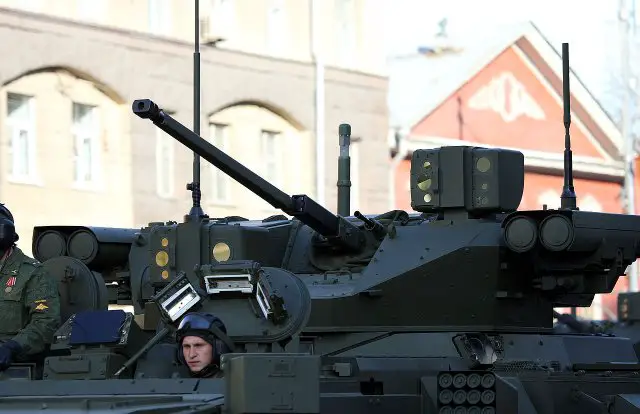T-15 Armata HIFV to increase combat capabilities of Russian Land Forces 51008166
|
|
|||
|
Defence & Security News - Russia
|
|||
|
|
|||
| T-15 Armata HIFV to increase combat capabilities of Russian Land Forces | |||
|
Russia`s newest T-15 heavy infantry fighting vehicles (HIFV) based on the Armata unified tracked platform will significantly beef up the combat capabilities of the Russian Land Forces, local sources suppose.
|
|||
|
|
|||
 The T-15 Armata HIFV at Moscow Victory Parade 2015 (Photo Vitaly Kuzmin) |
|||
|
|
|||
|
According to a source in the indigenous defense industry, over 10 low-rate initial production (LRIP) T-15 Armata HIFVs have been delivered to the Russian MoD. "At present, the developer of T-15, Uralvagonzavod (Russian acronym: UVZ) scientific-research corporation and the MoD are actively testing the vehicles. The HIFV has retained a number of T-14 Armata main battle tank`s (MBT) systems and subsystems, namely, hull, engine, suspension and explosive reactive armour (ERA). Such decision allows not only reducing the platform`s cost, but also increasing of its armour and electronic protection. At the same time, the internal layout of the T-15 HIFV significantly differs from the T-14 MBT. The engine compartment has been relocated to the front part of the vehicle. The crew of the vehicle is placed behind the powerpack. The remaining part of the hull comprises the troop compartment. T-15 has retained the driver`s seat of T-14, while the gunner and the commander of the HIFV have received new controls due to the introduction of the new weapons suite," he said.
The source pointed out that the T-15 HIFV features the Epokha (Epoch) remote controlled weapon station (RCWS) armed with the stabilized 30mm Shipunov 2A42 automatic cannon chambered for 30x165mm round, four ready-to-launch 9M133 Kornet/Kornet-D (NATO reporting name: AT-14 Spriggan) anti-tank guided missiles (ATGM) with high-explosive anti-tank (HEAT) warheads, and a Kalashnikov PKTM co-axial machinegun chambered for 7.62x54Rmm round. He did not mention the ammunition load of the Epokha RCWS. In basic configuration, the 2A42 automatic gun has 500 rounds of ready-to-fire ammunition, including 160 armour-piercing and 340 high-explosive (HE) fragmentation ones, while PKTM has about 2,000 7.62mm cartridges. The 2A42 gun has an effective firing range of 1,500 m against personnel targets and 4,000 against armour targets, while Kornet/Kornet-D ATGMs can destroy enemy`s tanks at 5,000 m and 10,000 m, respectively. The PKTM machinegun can eliminate adversary`s infantry at distances up to 2,000 m. The station`s sensors suite is comprised of two stabilized day-night optoelectronic sighting systems with integrated high-resolution thermal imagers and laser rangefinders, an advanced computer-based fire control system (FCS), and a meteorological sensor similar to the one fitted to T-72B3 and T-90A MBTs. A panoramic sight provides to the commander the ability to work in the hunter-killer mode. The Russian defense industry has developed the AU-220M Baikal RCWS that is supposed to be fitted to the T-15 HIFV in the near future. AU-220M developed by the TsNII Burevestnik (a subsidiary of UVZ) scientific-research institute features a 57mm semi-automatic naval gun. The developer is integrating the Kornet and 9M120 Ataka ATGMs (AT-9 Spiral-2) with the station. |
|||
|
|
|||
 The T-15 Armata turret (Photo Vitaly Kuzmin) |
|||
|
|
|||
|
The source said that T-15 Armata features "an unprecedented level of armour protection". The HIFV has received the newest Malakhit (Malachite) explosive reactive armour (ERA) developed by the NII Stali scientific-research institute (a subsidiary of the Tractor Plants Concern). "The Malakhit ERA protects the HIFV against state-of-the-art armour-piercing fin-stabilized discarding sabot (APSFDS) rounds, such as DM53/DM63 developed by Rheinmetall Defense and M829A3 by the Orbital ATK Corporation. I suppose that it can withstand even M829E4 APFSDS round being developed by Orbital ATK, let alone modern ATGMs, for instance, FGM-148 Javelin or MMP (Missile Moyenne Portee)," the source emphasized. T-15 HIFV also features improved passive composite armour made of steel and ceramic plates. The rear part of the vehicle is covered by bar-slat armour in order to provide additional protection against rocket-propelled anti-tank grenades equipped with HEAT warheads. The HIFV`s floor is reinforced with an additional armour plate to increase the counter-mine and counter-IED (Improvised Explosive Device) protection. The platform features both hard-kill (Afghanit) and soft-kill (optoelectronic suppression device) active protection systems (APS). The developer decided to use a special paint that significantly reduces the vehicle`s infrared signature. "T-15 has received several smoke grenade launchers. The HIFV also features a nuclear, biological, chemical, and radiological (NBCR) protection system, situational awareness cameras, and a jamming system to detonate radio-controlled anti-tank mines in front of the vehicle," the source added.
The T-15 HIFV is powered by a new generation multifuel diesel engine (1,500 h.p.) coupled with a hydro-mechanical automatic transmission. "The vehicle has a combat weight of about 48 t, a maximum road speed of 65-70 km/h, an operational range of 550 km, and a power-to-weight ratio of over 30 h.p./t," the source said. He pointed out that the UVZ Corporation is evolving the Armata family. "At present, the company is developing the T-16 Armata-based armoured recovering vehicle (ARV) to complement the MBT and the HIFV," the source added. |
|||
|
|
|||
|
|
|||
|
© Copyright 2016 TASS. All rights reserved. This material may not be published, broadcast, rewritten or redistributed.
|
|||


























